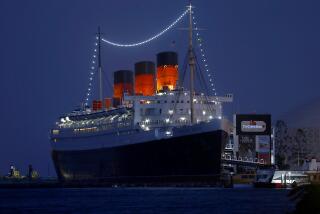The moral costs of cruise holidays
- Share via
The modern cruise industry was born a little more than 30 years ago, when the company that would become industry behemoth Carnival Corp. started sailing a single ship from Florida. Now cruise ships carry more than 12 million passengers yearly, few of whom dwell on the business’ environmental and social underpinnings. It was about time for a book like this.
Klein, a professor of social work in St. John’s, Newfoundland, isn’t necessarily the author you would expect to be behind a work of seafaring muckraking, and his writing style never rises above the prosaic. But he has facts.
Klein has taken more than 30 cruises (with his eyes and notebook open, clearly), and his data-marshaling shows he has been a diligent researcher.
He has also organized his case solidly, moving from an industry overview to three principal problem areas: safety at sea (from ship security to on-board medical care); pollution (more than $30 million in federal fines against Royal Caribbean International alone for illegal environmental practices); and employee wages (frequently below the U.S. legal minimum) and working conditions. Klein makes clear that much of the cruise industry’s success is built on a foundation of exploitative practices.
Through their shrewd use of often lax international laws and often desperate foreign laborers, the cruise industry’s leaders have crafted a remarkable and attractive product, a product that has endured and grown by giving Americans vacation satisfaction to rival the resorts of Las Vegas and Hawaii.
As any Carnival or Royal Caribbean alumnus can attest, a big, ethnically diverse chunk of middle-class America has been won over by cruising. In his haste to get to the horror stories (and there are plenty), Klein probably understates the value that the cruise industry gives most of its customers.
But he does a great service by reminding us of the often hidden costs behind the product: not only the pollution, but also the distorted local economies in ports from the Caribbean to Alaska, and the extra charges (from drinks to tips to spa services) that inevitably stack up on top of the all-inclusive cruise price.
If Klein’s criticisms don’t scare you away from ships altogether, in fact, they may well help you extract better value while you’re aboard them.
He writes with particular authority about food. Despite the well-heaped buffet tables that make such an impression on first-time cruisers, Klein reports, the industry average expenditure on food (as of 1994) was just $12 per passenger per day. (How do they do it? Volume.)
It’s an awkward mission, however, to complain about bad service and defiant workers (as Klein occasionally does) and then a few pages later explain how those workers, recruited from poverty in such countries as the Philippines, India and Indonesia, often log 98-hour weeks, live in cramped, windowless cabins and go nine months without a break.
But Klein’s larger goal is to sketch in the social and environmental context that most cruise lines would rather you not consider, and this he has done well.
Vacations with a social conscience
This book is an institution, now in its eighth edition. It’s built around a simple idea: to list organizations worldwide (more than 200 here) with programs that might help a traveler make the world a better place. Trail-building in the Appalachians, teaching in Kenya, doing grunt work on science projects along Mexico’s Pacific Coast are among them, typically listed with brief descriptions of organizations and contact information, including Web sites.
The format may put you off at first -- listings are alphabetical by organization, so Landmark Volunteers (who do maintenance on outdoor sites in the U.S.) are cheek by jowl with the Latin American Language Center. But if you have a specific agenda in mind, you can check the indexes in the back, which arrange organizations by geography, cost, time commitment, type of work and other variables.
A valuable guide to places to stay
For 20 years, Lanier has been offering and updating this guide, which now includes more than 4,000 lodgings from Alabama to Egypt. A list this long is a valuable tool, and the entries include specific prices, which is nice.
But be careful. This guide is not an independent appraisal. (Also, a computer search suggests that the admiring Los Angeles Times quotation cited on the book’s blurb page hasn’t run in the last 17 years.) The descriptive sentences in italics by each entry were written by the innkeepers themselves -- hence the heavy use of such words as “elegant,” “eclectic,” “historic” and “gourmet.”
*
Christopher Reynolds’ books column runs twice a month.
More to Read
Sign up for The Wild
We’ll help you find the best places to hike, bike and run, as well as the perfect silent spots for meditation and yoga.
You may occasionally receive promotional content from the Los Angeles Times.







